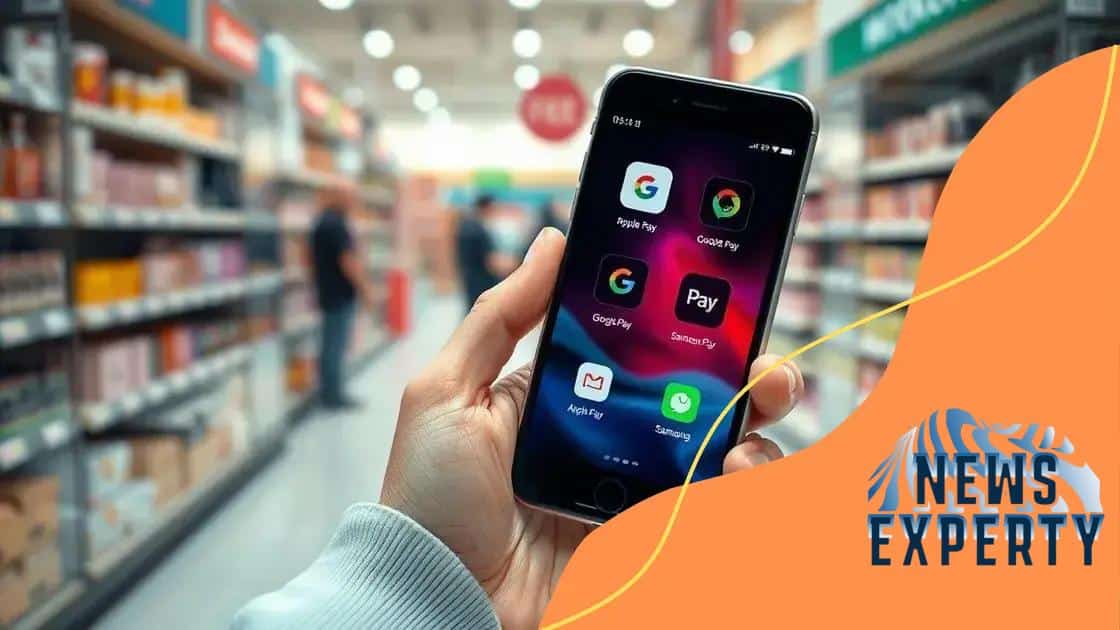The growing role of mobile payment systems in retail

Anúncios
The growing role of mobile payment systems in retail streamlines transactions, enhances customer satisfaction, and provides retailers with valuable data, fundamentally transforming how consumers shop and pay.
The growing role of mobile payment systems in retail is changing how we shop and pay. Ever thought about how these systems can make your life easier? Let’s dive into their impact and benefits.
Anúncios
Understanding mobile payment systems
Mobile payment systems are becoming essential in today’s retail landscape. These systems allow consumers to make purchases using their mobile devices quickly and securely. Understanding how they work is crucial for retailers and customers alike.
What Are Mobile Payment Systems?
Mobile payment systems refer to financial transactions conducted through mobile devices. They facilitate payments via apps, mobile wallets, or even SMS. By leveraging technologies like NFC and QR codes, these systems offer a seamless shopping experience.
Anúncios
Benefits of Mobile Payments
There are many advantages to using mobile payment systems:
- Convenience: Shoppers can pay anywhere, anytime with just a few taps.
- Speed: Transactions are usually completed in seconds, reducing wait times.
- Enhanced Security: Mobile payments often use encryption and tokenization, making them secure.
- Loyalty Programs: Many apps integrate loyalty perks, rewarding customers instantly.
The ease and functionality of mobile payments have made them popular among consumers. They provide a modern solution that caters to our fast-paced lives.
Moreover, retailers can offer promotions and discounts directly to customers’ devices, making it easier to engage with shoppers. As mobile payment systems evolve, they increasingly incorporate features like social sharing and budgeting tools.
Adopting mobile payment systems not only improves customer satisfaction but also streamlines operations for businesses. This innovation helps retailers manage transactions efficiently, ultimately leading to increased sales.
Benefits for retailers and consumers
Mobile payment systems offer several advantages for both retailers and consumers. These benefits can enhance shopping experiences and improve business operations.
Advantages for Retailers
For retailers, adopting mobile payment systems can lead to increased sales and customer satisfaction. By providing diverse payment options, they cater to more customers. Additionally, mobile payments help streamline transactions.
- Faster Transactions: Mobile payments reduce checkout times, making the shopping experience smoother for customers.
- Cost Savings: By minimizing cash handling and associated risks, retailers can save on operational costs.
- Data Collection: Retailers gain valuable insights into customer preferences and purchasing behavior.
These improvements not only boost efficiency but also contribute to a better overall shopping experience.
Benefits for Consumers
Consumers also reap significant rewards from mobile payment systems. With user-friendly interfaces and convenient features, these systems enhance convenience.
- Easy Access: Customers can shop and pay without needing physical cash or cards.
- Tracking Expenses: Many mobile payment apps allow users to monitor their spending easily.
- Rewards and Promotions: Customers can enjoy instant access to special offers and loyalty programs directly on their phones.
Overall, mobile payment systems have revolutionized how we shop, offering seamless experiences and significant benefits. As technology advances, this trend will only grow stronger, making shopping more accessible and efficient for everyone.
Popular mobile payment frameworks

There are several popular mobile payment frameworks that businesses and consumers frequently use. Understanding these frameworks can help both groups choose the best option for their needs.
Top Mobile Payment Frameworks
Some of the most widely used mobile payment frameworks include:
- Apple Pay: This service allows users to make payments using their Apple devices quickly. It offers strong security and ease of use.
- Google Pay: Designed for Android users, Google Pay integrates seamlessly with other Google services and offers fast transactions.
- Samsung Pay: This framework works with various payment terminals, including those too old for NFC. Users can make secure transactions with ease.
Each of these frameworks has unique features that cater to different user needs. For example, Apple Pay users enjoy a straightforward interface combined with top-notch security.
Emerging Alternatives
In addition to these giants, there are various emerging mobile payment options gaining traction. These alternatives often target specific regions or demographics, providing tailored solutions.
- Venmo: Primarily used for peer-to-peer payments, Venmo is popular among younger users who enjoy its social features.
- PayPal: Known for online transactions, PayPal also offers mobile payment solutions that allow users to pay in-store using their mobile devices.
- WeChat Pay: Popular in China, WeChat Pay is deeply integrated into the WeChat app, enabling various payments from bills to shopping.
As mobile payment technology evolves, these frameworks will likely continue to expand and adapt, providing more options for consumers and retailers. Embracing these systems can significantly enhance the shopping experience.
Implementation strategies for retailers
Implementing mobile payment systems can greatly enhance the shopping experience for consumers while boosting sales for retailers. Adopting these technologies requires careful planning and execution.
Steps for Successful Implementation
To effectively introduce mobile payment systems, retailers should consider several key steps:
- Assess Current Infrastructure: Evaluate existing payment systems to determine compatibility with mobile solutions.
- Choose the Right Provider: Research different mobile payment providers, looking for features like security, cost, and customer service.
- Train Employees: Ensure staff members are fully trained on how to use the new system and assist customers.
A smooth implementation process can set the foundation for long-term success.
Enhancing Customer Experience
Retailers should focus on improving customer interactions through mobile payments. Simplifying the checkout process can significantly affect customer satisfaction. Offering various payment options ensures that all customers feel comfortable and secure. Furthermore, consider integrating loyalty programs directly into the mobile payment experience.
Marketing and Communication
Once a mobile payment system is in place, retailers must communicate its benefits to their customers. This can be done through:
- In-Store Signage: Clearly display information about mobile payment options at checkout.
- Email Campaigns: Inform customers about new payment options through newsletters or promotions.
- Social Media: Utilize platforms like Facebook and Instagram to promote the ease of mobile payments.
These strategies help build awareness and encourage more customers to adopt mobile payment options. The right implementation of mobile payment systems can transform the retail environment.
Future trends in mobile payments
The future of mobile payments is filled with exciting trends that will shape how consumers and retailers interact. As technology advances, these changes will enhance security and convenience for everyone involved.
Integration of AI and Machine Learning
Artificial intelligence and machine learning are set to transform mobile payment systems. These technologies can help predict customer behavior, personalize offers, and streamline transaction processes. For instance, mobile payment apps will likely use AI to provide tailored promotions based on past purchases.
Increased Focus on Security
As mobile payments grow, security will remain a top priority. Technologies like biometrics, encryption, and tokenization will be essential in ensuring safe transactions. With rising concerns over data privacy, users will look for systems that offer strong protection against fraud and unauthorized access.
Contactless Technology Adoption
Contactless payments are becoming more popular as consumers seek faster, more convenient ways to pay. Many retailers are already upgrading their systems to support NFC (Near Field Communication) and QR codes. This trend will continue as more people prefer minimal contact during transactions.
Blockchain Technology in Payments
Blockchain is gaining traction as a potential backbone for mobile payment systems. Its decentralized nature means transactions can be processed faster and more securely. Retailers might benefit from reduced fees and improved transaction transparency, making blockchain an attractive option.
Social Media Integration
The rise of e-commerce on social media platforms is creating new opportunities for mobile payments. Consumers will likely make purchases directly through apps like Instagram and Facebook, making seamless payment options essential. In-app payment systems will streamline the process, driving sales and improving user experiences.
As the mobile payment landscape evolves, staying informed about these trends will help both retailers and consumers make the most of this technology. Embracing the future will create a more efficient and enjoyable shopping experience.
FAQ – Frequently Asked Questions about Mobile Payment Systems
What are mobile payment systems?
Mobile payment systems allow consumers to make purchases using their mobile devices, providing a quick and secure way to pay.
How do mobile payments enhance security?
Mobile payments use technologies like encryption and tokenization to protect users’ personal and financial information during transactions.
What benefits do retailers gain from mobile payment systems?
Retailers can benefit from faster transactions, improved customer satisfaction, and access to data that helps them understand buying behavior.
What future trends should we expect in mobile payments?
Future trends include increased adoption of AI, growth in contactless payments, and utilization of blockchain technology for security and efficiency.





